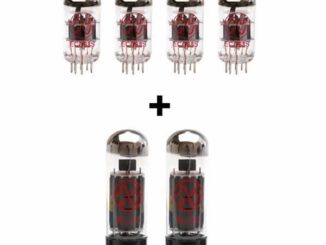
Why is it that when manufactures rate their stereo amplifiers at say, 40 watts, the back panel will usually read 20×20? Is that really 40 watts? And if I run two 60-watt mono amps through a stereo signal processor, using one amp for each channel, does that make 120 watts? I’m also very confused about matching heads and cabinets. Could you explain the whole ohm thing?
Chad Baker
Irvine California
Everyone has heard the terms “peak” and “RMS” power; they’re the most commonly used power measurements, RMS stands for “Root Mean Square,” and is a mathematical averaging of an amp’s ability to deliver clean, undistorted power. “Peak” generally refers to the maximum power capability of an amp, full blown and distorted. An amp’s peak power is usually just short of twice RMS rating. So, if each channel of your stereo amp is rated at 20 watts RMS, you’ll have a sum total of 40-watts RMS. But, the peak power, depending on the amp’s design, will be around 80-watts or so (combined). These numbers hold true whether you have a single stereo amp or two separate mono amps (60W X 60W = 120W).
Now to the more complex part of your question. Dead German physicist George Simon Ohm’s law is R=E/I (I=Current [amps], E=Electromotive Force [volts] and R=Resistance/Impedance [ohms].) When we flip it around for our guitar amp purpose we get:
(R1)(R2) Impendence of two
———- = speakers in a parallel circuit
R1 + R2
————————————————————
This formula will work for the majority of cabinets. The other type of wiring is called “series,” and is generally found only in the internal circuits of cabinets. If you need to calculate the impedance of a series circuit, just add up the resistance (R1+R2+R3=cab impedance).
Generally, you won’t need to do any heavy math for most amp/cab combinations, because if you are using two matching cabinets in parallel, all you have to do is divide the impedances in two. For example, the impedance of two 16ohm cabinets is 8ohm. But if you get stuck with two mismatched cabinets, let’s say one at 16ohm and the other at 8ohm; you’ll have to use the big formula to arrive at an impedance of 5.33ohm. In this situation, you could set your amplifier to 4ohm without doing any damage, but the 8ohm cabinets will be doing twice the work and be much louder than the 16ohm cabinet—not good for the speakers and a waste of the power-handling capabilities of the 16ohm cab. Its best not use mismatched cabinets. You run the risk of damaging your amp, like Marshall, Hiwatt and Soldano, have speaker jacks wired in parallel with a selector to produce the right impedance from the output transformer. With this type of setup, you simply do the math and plug in. On Fender and Mesa Boogie amps you’ll find one jack labeled 8ohm and, usually, two others, labeled 4ohm. If you have one 8ohm cabinet, plug it into the 8ohm jack; if you have two 8ohm cabinets, plug them into the 4ohm jacks.
Gear-Vault is an eBay alternative. Come sell with us!





Be the first to comment